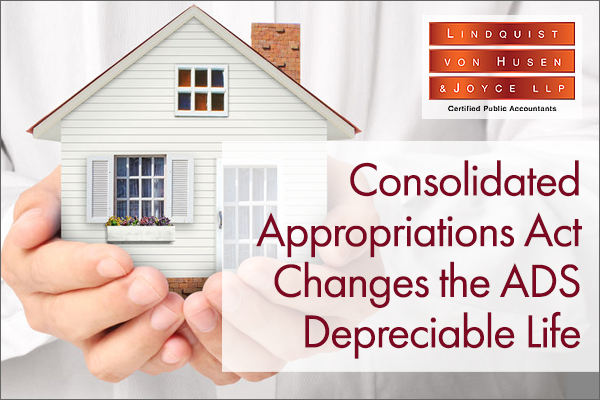
The Consolidated Appropriations Act, 2021 (CAA), signed into law on December 27, 2020 by President Trump, included provisions that shorten the depreciable life under the Alternative Depreciation System (ADS) for pre-2018 residential real estate for an IRC Sec. 163(j)(7)(A)(ii) electing real property trade or business. For residential real estate placed in service prior to January 1, 2018, the ADS depreciable life was 40 years. CAA changes the ADS depreciable life, under certain circumstances, from 40 years to 30 years for pre-2018 residential real estate. Before we delve further into the change brought by CAA, let’s look at some background information.
ADS Background Information
- Under the General Depreciation System (GDS), the depreciable life for residential real property is 27.5 years.
- Prior to the 2017 Tax Cuts and Jobs Act (TCJA), under the Alternative Depreciation System (ADS), the depreciable life for residential real property was 40 years.
- TCJA changed the ADS depreciable life to 30 years for residential real property placed in service after December 31, 2017.
- TCJA introduced a rule limiting the amount of interest deduction for certain taxpayers.
- TCJA allowed certain taxpayers to elect out of the interest deduction limitation by making a real property trade or business (RPTOB) election under IRC Sec. 163(j)(7)(A)(ii).
- As a condition for making the RPTOB election, if the taxpayer was using the GDS-27.5 year depreciation method for residential real property, the taxpayer is required to convert the depreciation method from GDS to ADS. Prior to enactment of CAA, it would be ADS-40 year for residential real property placed in service before January 1, 2018 and ADS-30 year for properties placed in service on or after January 1, 2018. The conversion from GDS to ADS results in a longer depreciable life and hence, a lesser amount of annual depreciation expense.
Changes to the ADS Life Pursuant to CAA
The CAA is providing relief for taxpayers that made the RPTOB election and had converted the depreciation method from GDS-27.5 year to ADS-40 year. CAA is now allowing taxpayers that are making the RPTOB election to use ADS-30 year, rather than ADS-40 year, for all residential real properties that had been using GDS including those properties that were placed in service prior to January 1, 2018. The change introduced by CAA, resulting in a higher amount of annual depreciation expense, is retroactive to tax years beginning after December 31, 2017. Please note that properties which were already subject to ADS prior to the RPTOB election are not impacted by the change.
At this time, there is still uncertainty on how a taxpayer should effectuate a retroactive change in depreciation. We believe a taxpayer can file an amended return or an administrative adjustment request to make depreciation changes on a prior tax return, or a taxpayer may request a change in accounting method on the 2020 tax return and pick up the “catch-up” depreciation adjustments all in the current tax year. One last option may be for the taxpayer to do nothing on the previously filed return and continue to claim depreciation using ADS-40 year on those pre-2018 properties. Hopefully, additional guidance from the Internal Revenue Service will be forthcoming soon.
For changes to the RPTOB election under the CARES Act, please refer to our earlier blog, Changes to Sec. 163(j) that Impacts LIHTC Partnerships Under CARES ACT.
If you have any questions about ADS or depreciation in general, please contact us at info@lvhj.com or connect with your engagement lead member directly.








